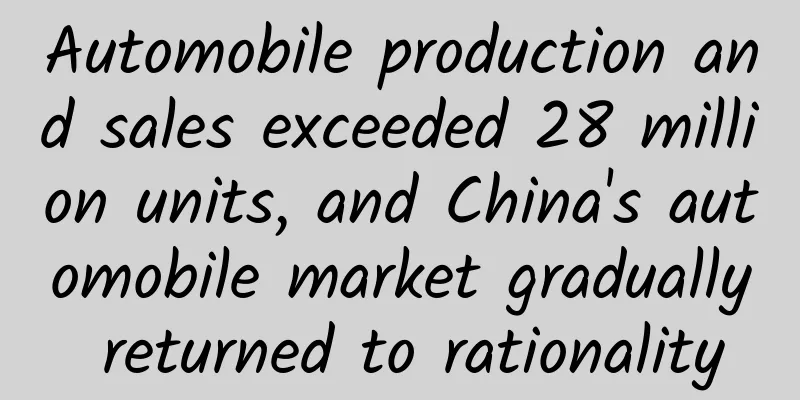Automobile production and sales exceeded 28 million units, and China's automobile market gradually returned to rationality

|
2016 is the first year of the 13th Five-Year Plan. Under the influence of the continuous release of macroeconomic policy effects, the automobile industry has stepped up supply-side reforms, the pace of product structure adjustment and renewal has continued to accelerate, and the growth rate of production and sales has increased month by month. Influenced by factors such as the purchase tax preferential policy, my country's automobile production and sales hit a new historical high in 2016. The double-digit growth has put the auto market on a restorative growth track. In the face of increasingly fierce competition in 2017, can the Chinese auto market continue to burst with vitality under the influence of factors such as the decline in purchase tax and stricter review of new energy subsidies? This special issue will conduct a detailed analysis of this. In 2016, China's passenger car market ended with a high sales growth of 13.7% year-on-year. After bidding farewell to the sales "trough" in 2015, China's automobile industry has recovered and entered a period of restorative growth. According to data released by the China Association of Automobile Manufacturers (hereinafter referred to as CAAM) on January 12, 2017, the production and sales of automobiles in 2016 reached 28.119 million and 28.028 million respectively, up 14.5% and 13.7% year-on-year respectively, 11.2 and 9.0 percentage points higher than the same period last year. Except for February, when the year-on-year growth rate declined due to the Chinese New Year, the sales volume in other months was significantly higher than the same period last year, and the cumulative sales growth rate showed a "straight-line upward" trend, showing a general trend of strong production and sales. In this regard, Xiao Zhengsan, Secretary General of the China Automobile Dealers Association, said in an interview with a reporter from China Business News: "Due to the level of China's economic development and the accumulation of automobile consumption, the purchasing power of the automobile market exploded in 2016; at the same time, due to the policy of halving the purchase tax for passenger cars with a displacement of 1.6 liters and below, the sales growth rate of China's automobile market in 2016 was much higher than the full-year forecast, achieving a recovery growth. Although the purchase tax policy declined in 2017, it still has a certain stimulating effect on the market, so the forecast for the full-year growth rate remains cautiously optimistic." Growth "counterattack" As the Chinese auto market experienced a sluggish growth of 4.7% in 2015, the "comeback" in 2016 was obviously beyond the industry's expectations. Xiao Zhengsan admitted: "The growth in automobile sales in 2016 was a surprise. Because the data in 2015 was not optimistic, the industry initially failed to predict that my country's overall automobile production and sales could achieve double-digit growth." The latest statistics from the China Passenger Car Association (CPCA) show that in 2016, the cumulative sales volume of the narrow passenger car market reached 23.685 million vehicles, a year-on-year growth rate of 17%, which is 6.5 percentage points higher than that in 2015. Overall, the development of the automobile market reflects the growth characteristics of "low at the beginning of the year, high in the middle of the year, and stable in the fourth quarter". At the beginning of 2016, the market continued the trend of slight growth in the previous year; in June, the monthly growth rate of automobile sales achieved double-digit growth, and the year-on-year growth rate in July and August was as high as more than 20%. In the fourth quarter, the sales growth rate stabilized at around 20%, reflecting the strong pull effect of consumer demand. From the production and sales of the four types of passenger cars, compared with the same period last year, the production and sales of sedans increased by 3.9% and 3.4% respectively; the production and sales of SUVs continued to maintain a high growth rate, increasing by 45.7% and 44.6% respectively; the production and sales of MPVs increased by 17.1% and 18.4% respectively; the production and sales of crossover passenger cars decreased by 38.3% and 37.8% respectively. "In 2016, the growth of the SUV and MPV markets was a significant reason for the improvement of passenger cars throughout the year," Shi Jianhua, deputy secretary-general of the China Association of Automobile Manufacturers, told reporters. Compared with the overall growth figures of the auto market, which boosted people's confidence, the new energy vehicle sector seems to be unsatisfactory. According to the data of the China Passenger Car Association, in December 2016, the sales volume of new energy passenger vehicles was 38,000, with a year-on-year growth rate of only 2% and a month-on-month decline of 12%. The "tail-up" market that should have appeared at the end of the year did not appear. According to the data of the China Automobile Association, in 2016, the production of new energy vehicles was 517,000 and the sales volume was 507,000, an increase of 51.7% and 53% respectively over the same period of the previous year. Among them, the production and sales of pure electric vehicles were 417,000 and 409,000 respectively, an increase of 63.9% and 65.1% respectively over the same period of the previous year; the production and sales of plug-in hybrid vehicles were 99,000 and 98,000 respectively, an increase of 15.7% and 17.1% respectively over the same period of the previous year, entering a relatively healthy growth state. In fact, although my country's new energy vehicles have entered a period of rapid development, the sales volume of 500,000 vehicles in 2016 is still quite small compared to the overall sales of 28.02 million vehicles. Internal and external factors In the past five years, under the background of slow international economic recovery and national macroeconomic regulation, the automobile industry has undergone major changes under the influence of multiple external and internal factors. In 2016, China's economy stabilized and improved, and the release of new rigid demand for car purchases became the main driver of the rapid growth of the automobile market. "Although it is a double-digit growth, we still think it is a recovery growth." Xiao Zhengsan said that after experiencing a continuous slow growth from 2011 to 2015, the automobile market has ushered in a concentrated burst of purchasing power. "According to China's economic development level and the law of consumer accumulation of automobiles, the current economic development level and consumer accumulation are just within 5 years. This accumulation will trigger consumers' idea of buying a large commodity, and the income happens to match the purchasing power, which is reflected in automobiles." In addition, the industry generally believes that the growth of the auto market in 2016 was also strongly driven by the policy of halving the purchase tax for small-displacement vehicles of 1.6 liters and below. In September 2015, the State Council decided to implement a preferential policy of halving the vehicle purchase tax for the purchase of passenger cars with a displacement of 1.6 liters and below from October 1, 2015 to December 31, 2016. Once the policy was introduced, it immediately boosted the long-sluggish auto market. From October of that year, small-displacement models of many automakers were hot-selling, and the overall growth rate reached double digits at the end of the year. In fact, my country once implemented a purchase tax of 7.5% for cars with a displacement of less than 1.6 liters in 2010, and domestic car sales increased by 32.37% year-on-year that year. However, in 2011, after the policy ended, due to the slowdown in market demand after excessive consumption, the growth rate of car sales was only 2.45%, the lowest level in 13 years. Therefore, the implementation of the purchase tax preferential policy has a significant effect on the market response. Previously, industry insiders predicted that if the purchase tax is completely withdrawn in 2017, the Chinese auto market will see negative growth. "According to this approach, the growth of the entire Chinese auto market needs to be stimulated by policy," Xiao Zhengsan said, "This is a skeptical attitude towards the spontaneous growth of the Chinese auto market. We expect the market to achieve real growth through endogenous forces. If it relies on government stimulus or policy stimulus, it is definitely not a good thing." Insulation and cooling Just as the purchase tax halving policy was about to expire, the state extended the purchase tax preferential policy, but the intensity was weakened. According to the latest policy content, from January 1, 2017 to December 31, 2017, the purchase of passenger cars with a displacement of 1.6 liters or less will be subject to a vehicle purchase tax rate of 7.5%. From January 1, 2018, the vehicle purchase tax will be restored to the statutory tax rate of 10%. Therefore, the market is generally cautiously optimistic about the market outlook for 2017. Shi Jianhua believes that since the purchase tax preferential policy has not been "withdrawn" as the industry expected, but the preferential rate has been narrowed, it still has a certain guarantee effect on the market. This approach is a way to "keep the heat" in the auto market in 2017, but the new energy vehicle market is experiencing a long-lasting cooling. Since the government stepped up adjustments and strict supervision on new energy policies in the second half of 2016, the true market development status of the new energy market in 2017 is about to emerge. After the subsidy fraud incidents of some new energy vehicle enterprises in 2016, many policies have been revised and improved. The "New Energy Vehicle Carbon Quota Management Measures (Draft for Comments)" and "Interim Measures for the Parallel Management of Enterprise Average Fuel Consumption and New Energy Vehicle Credits" (Draft for Comments), which are regarded by the industry as replacing the subsidy policy, have been successively issued, proposing to manage fuel consumption and new energy vehicle credits in parallel and introduce them into the carbon emission market. These two policies will replace the previous financial subsidy method and guide the organic combination of industry and market. And a series of documents such as "Light Vehicle Pollutant Emission Limits and Measurement Methods (China Phase 6)" have also put energy conservation and consumption reduction back on the agenda of enterprises. On December 29, 2016, four ministries jointly issued the 2017 New Energy Vehicle Subsidy Plan, which stipulates that local subsidies shall not exceed 50% of central subsidies, and adjusts the liquidation procedures to strictly prevent fraudulent subsidies from happening again. This also indicates a subtle change in the industry trend. In the future, the new energy vehicle market will transform from subsidy-driven to innovation-driven. As a result, the Chinese auto market will gradually enter a stage of rational return. The industry generally believes that the growth rate of the Chinese auto market will slow down in 2017. Most analysis agencies are cautious about the sales trend for the whole year of 2017. "If there is no purchase tax subsidy policy, the growth rate of the auto market in 2017 can only be 2%." Shi Jianhua told reporters that this year's auto market growth will keep pace with GDP, with a year-on-year growth of 5%. Xiao Zhengsan, deputy secretary-general of the Automobile Circulation Association, believes that this year's auto market growth will be between 5% and 10%. As a winner of Toutiao's Qingyun Plan and Baijiahao's Bai+ Plan, the 2019 Baidu Digital Author of the Year, the Baijiahao's Most Popular Author in the Technology Field, the 2019 Sogou Technology and Culture Author, and the 2021 Baijiahao Quarterly Influential Creator, he has won many awards, including the 2013 Sohu Best Industry Media Person, the 2015 China New Media Entrepreneurship Competition Beijing Third Place, the 2015 Guangmang Experience Award, the 2015 China New Media Entrepreneurship Competition Finals Third Place, and the 2018 Baidu Dynamic Annual Powerful Celebrity. |
<<: Tesla says it has achieved fully autonomous driving, but I don't quite believe it
>>: Overvalued Toutiao may not be worth $10 billion
Recommend
Real-life and analysis of community operations
The concept of community operation is very popula...
What would happen if we asked Papi Jiang to be in charge of market operations?
Internet celebrities appear every year, and they ...
Countdown to Apple's conference, eight tips to help your APP gain enough presence for free
At 10 a.m. local time on March 21, or early morni...
19 best mobile development tools in Chinese with detailed explanations and download addresses
These days, just about every developer is familia...
"Unbelievable" is actually a quantifier? Netizen: It turns out that "100 million" is really a small goal!
The picture shows the inner page of "Mathema...
3 ways to improve user retention through APP operation!
With the disappearance of the Internet's demo...
How much does it cost to customize a large turntable mini program in Huangshan?
How much does it cost to customize the Huangshan ...
Is eating 200 of them equivalent to taking a chest X-ray? Can eating this radioactive fruit actually make people happy?
Expert in this article: Wang Silu, National Senio...
Some iPhone 6 cases reportedly failed Apple inspection, which may affect shipments
According to Taiwan's Economic Daily, there ha...
I'm going to share 48 tricks to attract fans. If you don't have fans anymore, you can only blame yourself.
I'm going to share 48 tricks to attract traff...
B2B Marketing Promotion!
The article shares practical experience and thoug...
Analysis of Xigua Video's Competitive Products
In early 2021, Xigua Video anchored mid-length vi...
To ease energy problems, can space-based solar energy become a reality?
According to Science and Technology Daily, the Eu...
2007-2015: Two tables to show the competition history between iPhone and Android
Mary Meeker has released the 2016 Internet Trends...
Staying up late = unhealthy? Not getting enough sleep for 8 hours is bad for your health? It's not that simple
Workers usually stay up late to work overtime, an...









